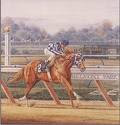Handicapper Dr. Howard Sartin, who saw potential winners in Thoroughbreds and in people, died on January 31. He was 82.
Sartin, of Beaumont, California, developed the Sartin Methodology which handicapped horse racing based on pace. The philosophy thrived in Southern California and gradually spread throughout the country.
Racing author Tom Brohamer outlined and added to Sartin’s ideas in his book, Modern Pace Handicapping, first published in 1991. Suddenly, terms like “early pace,” “turn times,” and “energy distribution” were widely used at the track.
“When you watch the handicappers on the racing channels like Television Games Network, it becomes very clear how much influence he had,” Brohamer said. “You hear many of them using pace terms that he developed.”
As important as any of his insights on pace, friends said Sartin also provided invaluable lessons on the psychology of betting races. He famously took a group of addicted gamblers to the track to teach them to be winners, not seeing their gambling as a problem so much as the losing.
“I read about that and wrote about it in my book,” Brohamer said. “No one has ever told me it’s not true. So I would say it must be true.”
Friend Ted Craven, who runs a website and offers computer software devoted to the Sartin Methodology, said Sartin believed a disciplined approach could help handicappers win at the races.
“All of his journals included the phrase, ‘The cure for losing is winning,’” Craven said.
For more than 15 years, Sartin published and contributed to a bi-monthly journal that also included guest writers. His methodology is outlined in the book Pace Makes the Race, which he co-wrote with Tom Hambleton, Dick Schmidt, and Michael Pizzolla.
“The world of handicapping owes a lot to ‘Doc’ Sartin,” Craven said. “Not only that, his thinking spun off a lot of other smart people. He seemed to attract smart people his whole life.”
In the handicapping world in which popular ideas can mean lower odds, Sartin preferred to stay low-key and limit the number of subscribers to his information. The power of those ideas proved too strong.
“He didn’t think much of a lot of the more popular handicappers,” Brohamer said with a laugh. “He preferred to work with a small group of handicappers, but the ideas are so powerful, they worked their way out into the general public.”
Craven said Sartin’s thoughts on racing continued to evolve from the mid-1980s through the years until he was slowed by a stroke in 2001. As of February 2, arrangements had not been announced.
.









































































